CBWT3103 Wireless Technology: Earth Orbit Analysis & Satellite Systems
VerifiedAdded on 2023/06/03
|11
|2586
|329
Report
AI Summary
This report provides an overview of satellite systems used in wireless technology, focusing on Geostationary Earth Orbit (GEO), Medium Earth Orbit (MEO), and Low Earth Orbit (LEO). It discusses the strengths and weaknesses of each orbit type, highlighting their applications in communication systems, particularly in broadcasting TV and radio signals. The report also includes a recommendation for Direct2U, a communication organization, suggesting the adoption of digital communication systems and accurate amplifiers to improve efficiency and reduce signal losses. The analysis emphasizes the importance of selecting the appropriate orbit based on specific communication needs and geographical considerations, concluding that GEO is an advanced technique suitable for long-distance communication and enhancing TV and radio system performance. Desklib provides a platform to explore similar solved assignments and past papers.
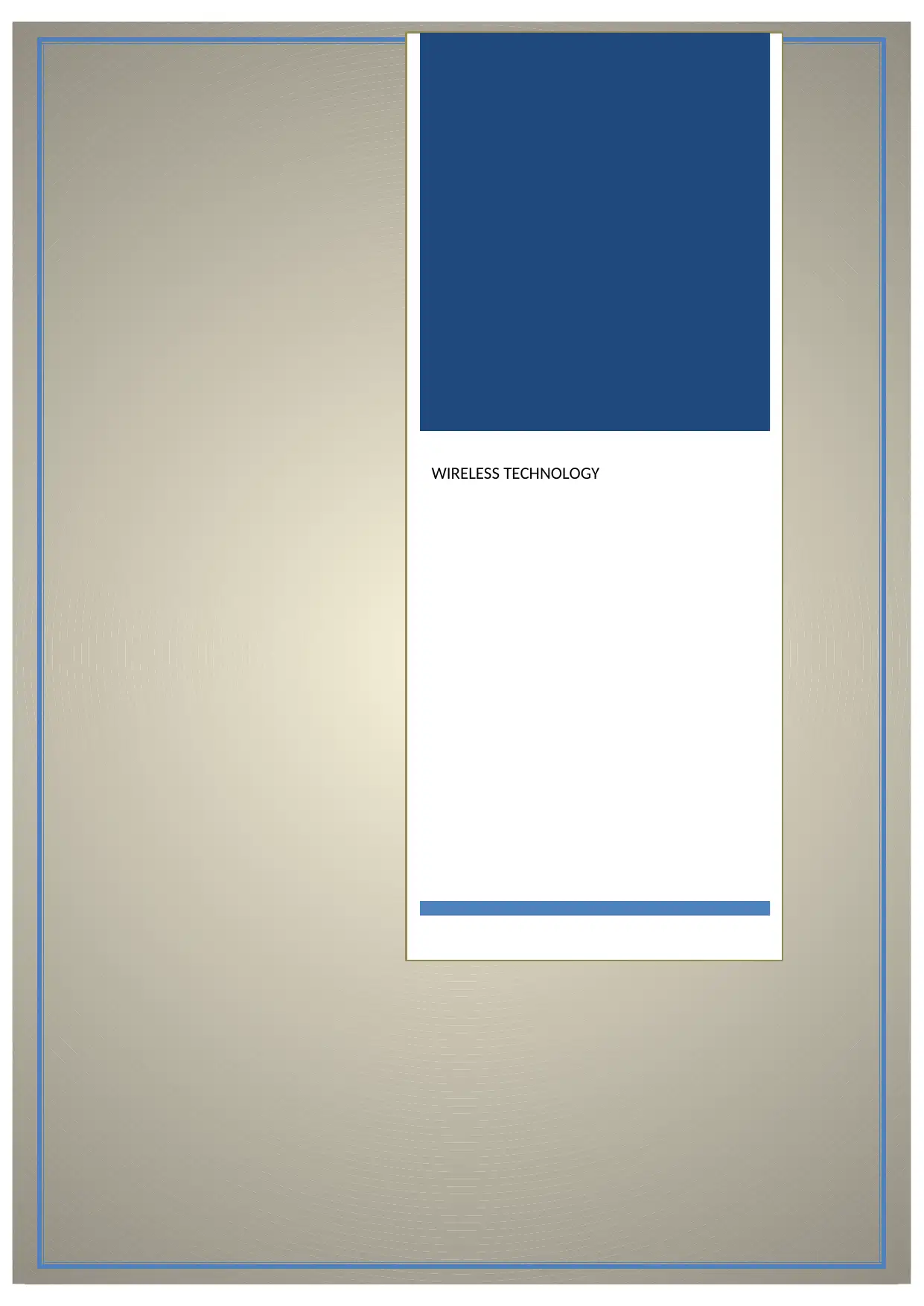
WIRELESS TECHNOLOGY
Paraphrase This Document
Need a fresh take? Get an instant paraphrase of this document with our AI Paraphraser
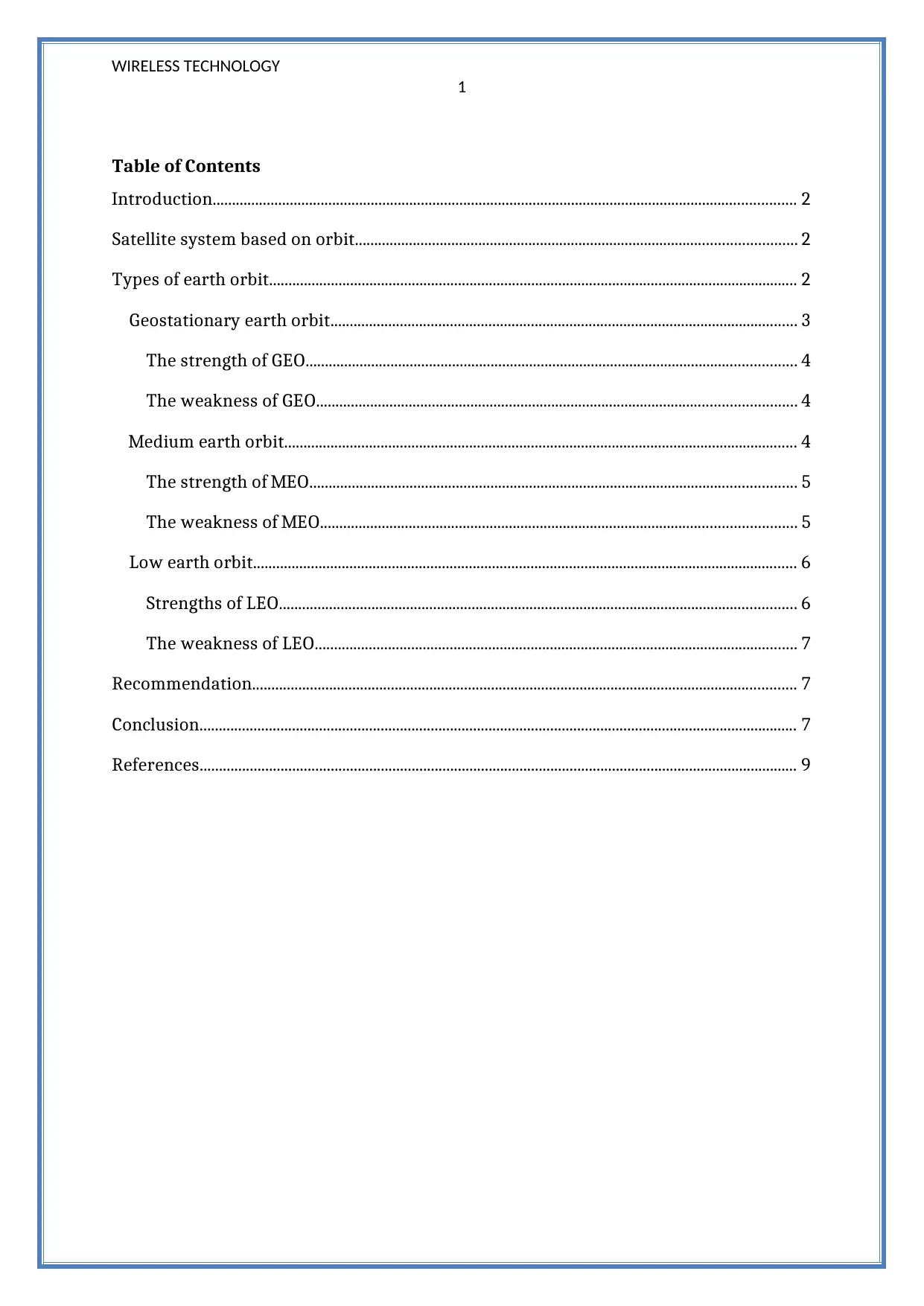
WIRELESS TECHNOLOGY
1
Table of Contents
Introduction....................................................................................................................................................... 2
Satellite system based on orbit.................................................................................................................. 2
Types of earth orbit......................................................................................................................................... 2
Geostationary earth orbit......................................................................................................................... 3
The strength of GEO............................................................................................................................... 4
The weakness of GEO............................................................................................................................ 4
Medium earth orbit..................................................................................................................................... 4
The strength of MEO.............................................................................................................................. 5
The weakness of MEO........................................................................................................................... 5
Low earth orbit............................................................................................................................................. 6
Strengths of LEO...................................................................................................................................... 6
The weakness of LEO............................................................................................................................. 7
Recommendation............................................................................................................................................. 7
Conclusion........................................................................................................................................................... 7
References........................................................................................................................................................... 9
1
Table of Contents
Introduction....................................................................................................................................................... 2
Satellite system based on orbit.................................................................................................................. 2
Types of earth orbit......................................................................................................................................... 2
Geostationary earth orbit......................................................................................................................... 3
The strength of GEO............................................................................................................................... 4
The weakness of GEO............................................................................................................................ 4
Medium earth orbit..................................................................................................................................... 4
The strength of MEO.............................................................................................................................. 5
The weakness of MEO........................................................................................................................... 5
Low earth orbit............................................................................................................................................. 6
Strengths of LEO...................................................................................................................................... 6
The weakness of LEO............................................................................................................................. 7
Recommendation............................................................................................................................................. 7
Conclusion........................................................................................................................................................... 7
References........................................................................................................................................................... 9
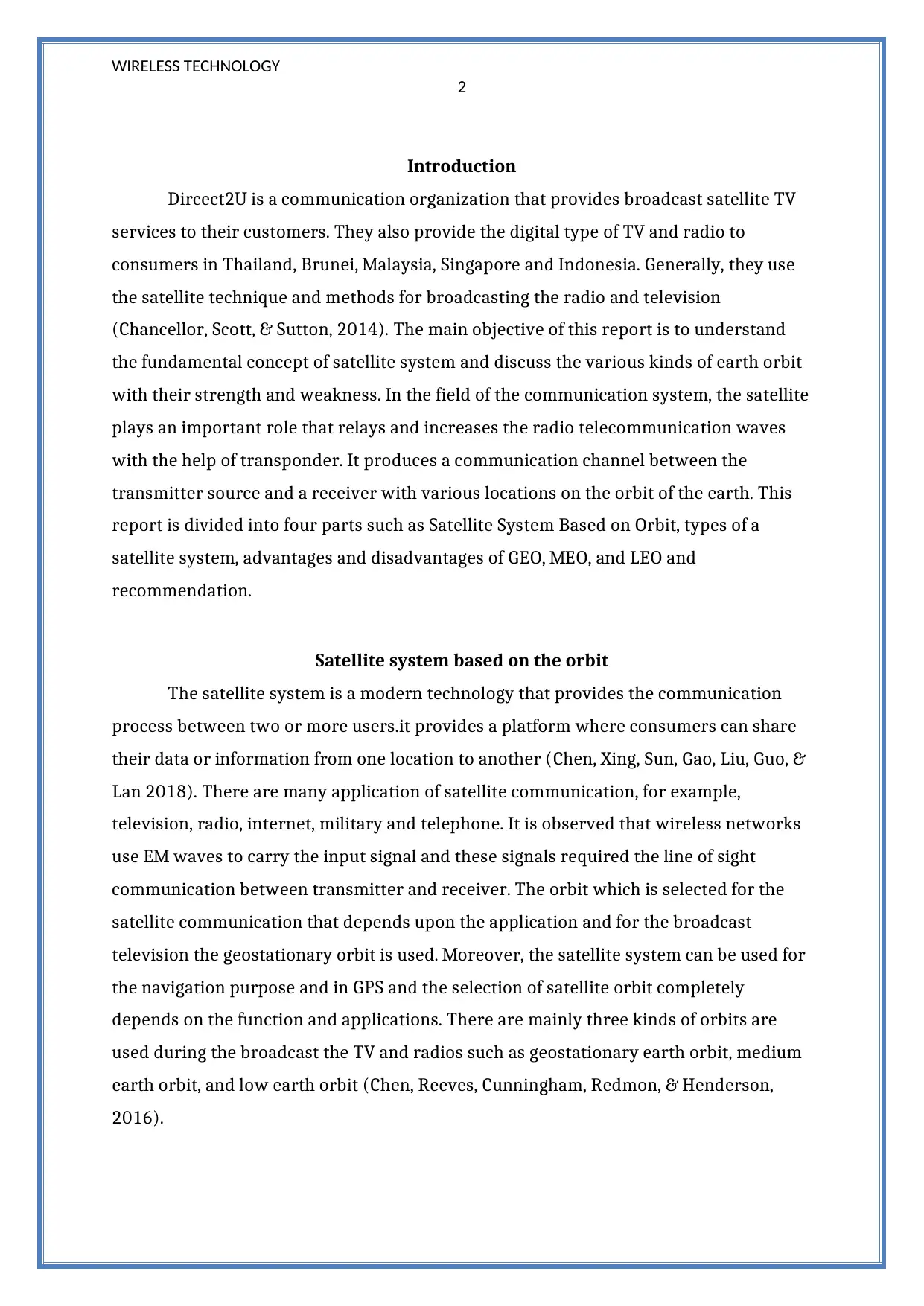
WIRELESS TECHNOLOGY
2
Introduction
Dircect2U is a communication organization that provides broadcast satellite TV
services to their customers. They also provide the digital type of TV and radio to
consumers in Thailand, Brunei, Malaysia, Singapore and Indonesia. Generally, they use
the satellite technique and methods for broadcasting the radio and television
(Chancellor, Scott, & Sutton, 2014). The main objective of this report is to understand
the fundamental concept of satellite system and discuss the various kinds of earth orbit
with their strength and weakness. In the field of the communication system, the satellite
plays an important role that relays and increases the radio telecommunication waves
with the help of transponder. It produces a communication channel between the
transmitter source and a receiver with various locations on the orbit of the earth. This
report is divided into four parts such as Satellite System Based on Orbit, types of a
satellite system, advantages and disadvantages of GEO, MEO, and LEO and
recommendation.
Satellite system based on the orbit
The satellite system is a modern technology that provides the communication
process between two or more users.it provides a platform where consumers can share
their data or information from one location to another (Chen, Xing, Sun, Gao, Liu, Guo, &
Lan 2018). There are many application of satellite communication, for example,
television, radio, internet, military and telephone. It is observed that wireless networks
use EM waves to carry the input signal and these signals required the line of sight
communication between transmitter and receiver. The orbit which is selected for the
satellite communication that depends upon the application and for the broadcast
television the geostationary orbit is used. Moreover, the satellite system can be used for
the navigation purpose and in GPS and the selection of satellite orbit completely
depends on the function and applications. There are mainly three kinds of orbits are
used during the broadcast the TV and radios such as geostationary earth orbit, medium
earth orbit, and low earth orbit (Chen, Reeves, Cunningham, Redmon, & Henderson,
2016).
2
Introduction
Dircect2U is a communication organization that provides broadcast satellite TV
services to their customers. They also provide the digital type of TV and radio to
consumers in Thailand, Brunei, Malaysia, Singapore and Indonesia. Generally, they use
the satellite technique and methods for broadcasting the radio and television
(Chancellor, Scott, & Sutton, 2014). The main objective of this report is to understand
the fundamental concept of satellite system and discuss the various kinds of earth orbit
with their strength and weakness. In the field of the communication system, the satellite
plays an important role that relays and increases the radio telecommunication waves
with the help of transponder. It produces a communication channel between the
transmitter source and a receiver with various locations on the orbit of the earth. This
report is divided into four parts such as Satellite System Based on Orbit, types of a
satellite system, advantages and disadvantages of GEO, MEO, and LEO and
recommendation.
Satellite system based on the orbit
The satellite system is a modern technology that provides the communication
process between two or more users.it provides a platform where consumers can share
their data or information from one location to another (Chen, Xing, Sun, Gao, Liu, Guo, &
Lan 2018). There are many application of satellite communication, for example,
television, radio, internet, military and telephone. It is observed that wireless networks
use EM waves to carry the input signal and these signals required the line of sight
communication between transmitter and receiver. The orbit which is selected for the
satellite communication that depends upon the application and for the broadcast
television the geostationary orbit is used. Moreover, the satellite system can be used for
the navigation purpose and in GPS and the selection of satellite orbit completely
depends on the function and applications. There are mainly three kinds of orbits are
used during the broadcast the TV and radios such as geostationary earth orbit, medium
earth orbit, and low earth orbit (Chen, Reeves, Cunningham, Redmon, & Henderson,
2016).
⊘ This is a preview!⊘
Do you want full access?
Subscribe today to unlock all pages.

Trusted by 1+ million students worldwide
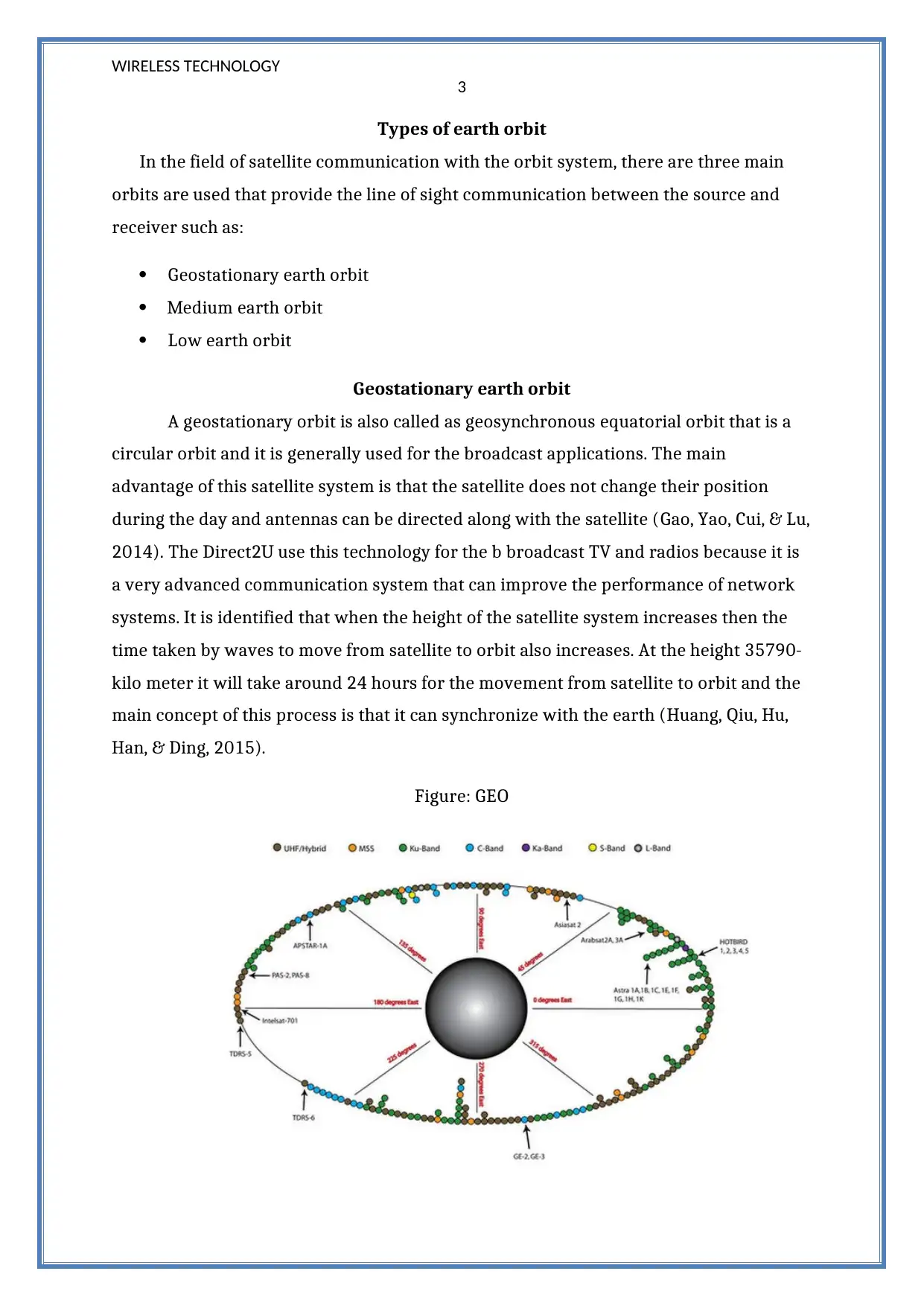
WIRELESS TECHNOLOGY
3
Types of earth orbit
In the field of satellite communication with the orbit system, there are three main
orbits are used that provide the line of sight communication between the source and
receiver such as:
Geostationary earth orbit
Medium earth orbit
Low earth orbit
Geostationary earth orbit
A geostationary orbit is also called as geosynchronous equatorial orbit that is a
circular orbit and it is generally used for the broadcast applications. The main
advantage of this satellite system is that the satellite does not change their position
during the day and antennas can be directed along with the satellite (Gao, Yao, Cui, & Lu,
2014). The Direct2U use this technology for the b broadcast TV and radios because it is
a very advanced communication system that can improve the performance of network
systems. It is identified that when the height of the satellite system increases then the
time taken by waves to move from satellite to orbit also increases. At the height 35790-
kilo meter it will take around 24 hours for the movement from satellite to orbit and the
main concept of this process is that it can synchronize with the earth (Huang, Qiu, Hu,
Han, & Ding, 2015).
Figure: GEO
3
Types of earth orbit
In the field of satellite communication with the orbit system, there are three main
orbits are used that provide the line of sight communication between the source and
receiver such as:
Geostationary earth orbit
Medium earth orbit
Low earth orbit
Geostationary earth orbit
A geostationary orbit is also called as geosynchronous equatorial orbit that is a
circular orbit and it is generally used for the broadcast applications. The main
advantage of this satellite system is that the satellite does not change their position
during the day and antennas can be directed along with the satellite (Gao, Yao, Cui, & Lu,
2014). The Direct2U use this technology for the b broadcast TV and radios because it is
a very advanced communication system that can improve the performance of network
systems. It is identified that when the height of the satellite system increases then the
time taken by waves to move from satellite to orbit also increases. At the height 35790-
kilo meter it will take around 24 hours for the movement from satellite to orbit and the
main concept of this process is that it can synchronize with the earth (Huang, Qiu, Hu,
Han, & Ding, 2015).
Figure: GEO
Paraphrase This Document
Need a fresh take? Get an instant paraphrase of this document with our AI Paraphraser
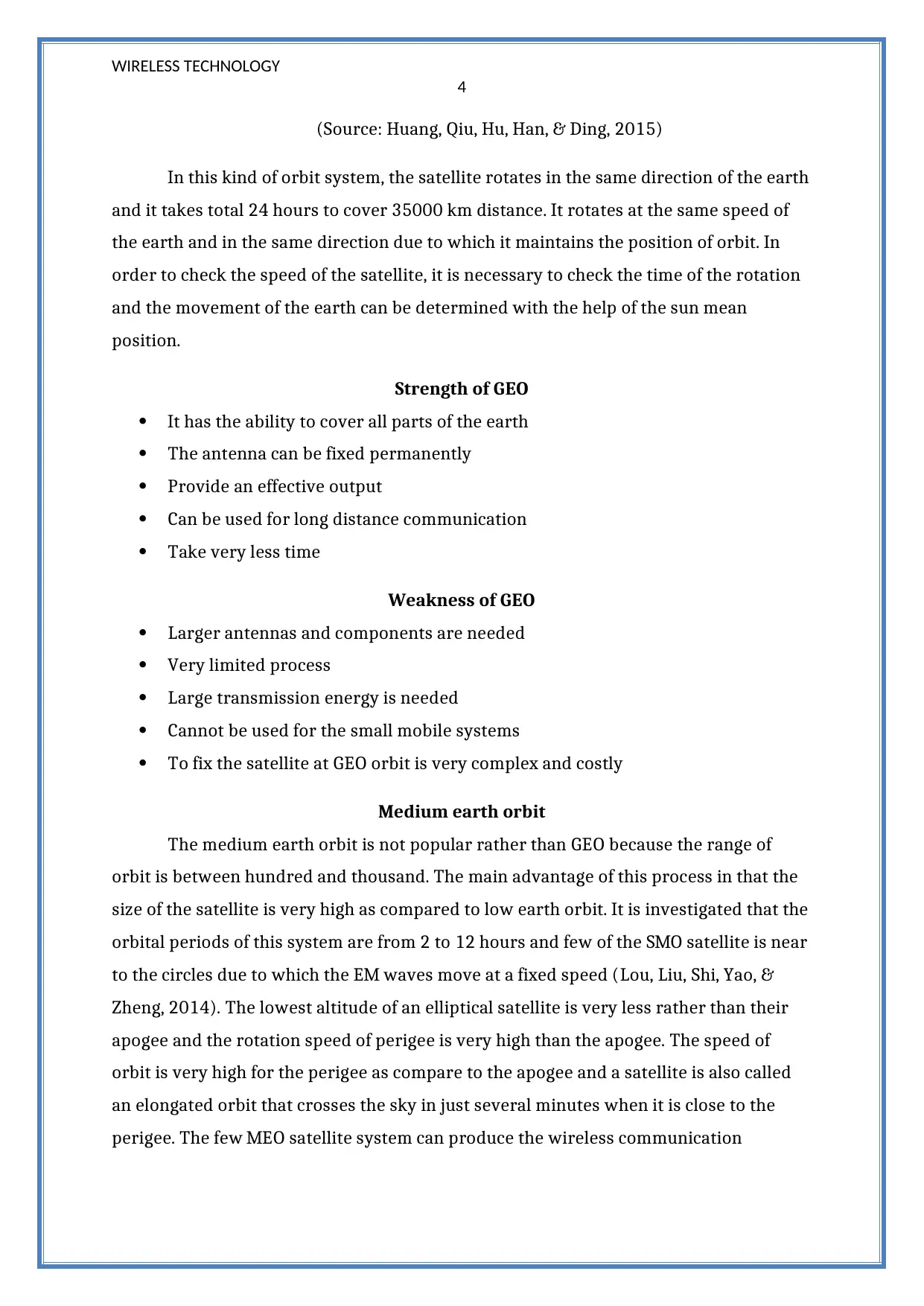
WIRELESS TECHNOLOGY
4
(Source: Huang, Qiu, Hu, Han, & Ding, 2015)
In this kind of orbit system, the satellite rotates in the same direction of the earth
and it takes total 24 hours to cover 35000 km distance. It rotates at the same speed of
the earth and in the same direction due to which it maintains the position of orbit. In
order to check the speed of the satellite, it is necessary to check the time of the rotation
and the movement of the earth can be determined with the help of the sun mean
position.
Strength of GEO
It has the ability to cover all parts of the earth
The antenna can be fixed permanently
Provide an effective output
Can be used for long distance communication
Take very less time
Weakness of GEO
Larger antennas and components are needed
Very limited process
Large transmission energy is needed
Cannot be used for the small mobile systems
To fix the satellite at GEO orbit is very complex and costly
Medium earth orbit
The medium earth orbit is not popular rather than GEO because the range of
orbit is between hundred and thousand. The main advantage of this process in that the
size of the satellite is very high as compared to low earth orbit. It is investigated that the
orbital periods of this system are from 2 to 12 hours and few of the SMO satellite is near
to the circles due to which the EM waves move at a fixed speed (Lou, Liu, Shi, Yao, &
Zheng, 2014). The lowest altitude of an elliptical satellite is very less rather than their
apogee and the rotation speed of perigee is very high than the apogee. The speed of
orbit is very high for the perigee as compare to the apogee and a satellite is also called
an elongated orbit that crosses the sky in just several minutes when it is close to the
perigee. The few MEO satellite system can produce the wireless communication
4
(Source: Huang, Qiu, Hu, Han, & Ding, 2015)
In this kind of orbit system, the satellite rotates in the same direction of the earth
and it takes total 24 hours to cover 35000 km distance. It rotates at the same speed of
the earth and in the same direction due to which it maintains the position of orbit. In
order to check the speed of the satellite, it is necessary to check the time of the rotation
and the movement of the earth can be determined with the help of the sun mean
position.
Strength of GEO
It has the ability to cover all parts of the earth
The antenna can be fixed permanently
Provide an effective output
Can be used for long distance communication
Take very less time
Weakness of GEO
Larger antennas and components are needed
Very limited process
Large transmission energy is needed
Cannot be used for the small mobile systems
To fix the satellite at GEO orbit is very complex and costly
Medium earth orbit
The medium earth orbit is not popular rather than GEO because the range of
orbit is between hundred and thousand. The main advantage of this process in that the
size of the satellite is very high as compared to low earth orbit. It is investigated that the
orbital periods of this system are from 2 to 12 hours and few of the SMO satellite is near
to the circles due to which the EM waves move at a fixed speed (Lou, Liu, Shi, Yao, &
Zheng, 2014). The lowest altitude of an elliptical satellite is very less rather than their
apogee and the rotation speed of perigee is very high than the apogee. The speed of
orbit is very high for the perigee as compare to the apogee and a satellite is also called
an elongated orbit that crosses the sky in just several minutes when it is close to the
perigee. The few MEO satellite system can produce the wireless communication
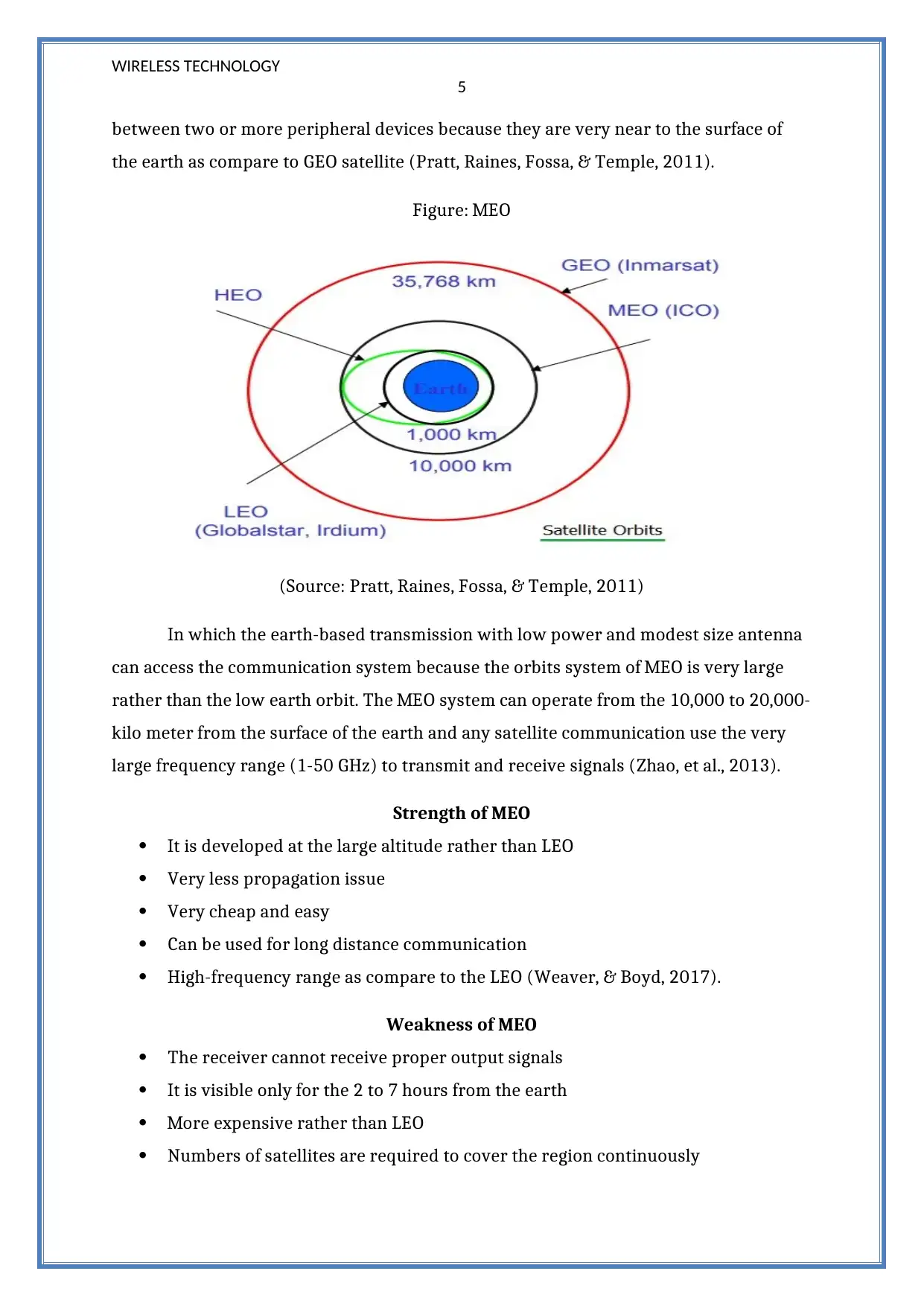
WIRELESS TECHNOLOGY
5
between two or more peripheral devices because they are very near to the surface of
the earth as compare to GEO satellite (Pratt, Raines, Fossa, & Temple, 2011).
Figure: MEO
(Source: Pratt, Raines, Fossa, & Temple, 2011)
In which the earth-based transmission with low power and modest size antenna
can access the communication system because the orbits system of MEO is very large
rather than the low earth orbit. The MEO system can operate from the 10,000 to 20,000-
kilo meter from the surface of the earth and any satellite communication use the very
large frequency range (1-50 GHz) to transmit and receive signals (Zhao, et al., 2013).
Strength of MEO
It is developed at the large altitude rather than LEO
Very less propagation issue
Very cheap and easy
Can be used for long distance communication
High-frequency range as compare to the LEO (Weaver, & Boyd, 2017).
Weakness of MEO
The receiver cannot receive proper output signals
It is visible only for the 2 to 7 hours from the earth
More expensive rather than LEO
Numbers of satellites are required to cover the region continuously
5
between two or more peripheral devices because they are very near to the surface of
the earth as compare to GEO satellite (Pratt, Raines, Fossa, & Temple, 2011).
Figure: MEO
(Source: Pratt, Raines, Fossa, & Temple, 2011)
In which the earth-based transmission with low power and modest size antenna
can access the communication system because the orbits system of MEO is very large
rather than the low earth orbit. The MEO system can operate from the 10,000 to 20,000-
kilo meter from the surface of the earth and any satellite communication use the very
large frequency range (1-50 GHz) to transmit and receive signals (Zhao, et al., 2013).
Strength of MEO
It is developed at the large altitude rather than LEO
Very less propagation issue
Very cheap and easy
Can be used for long distance communication
High-frequency range as compare to the LEO (Weaver, & Boyd, 2017).
Weakness of MEO
The receiver cannot receive proper output signals
It is visible only for the 2 to 7 hours from the earth
More expensive rather than LEO
Numbers of satellites are required to cover the region continuously
⊘ This is a preview!⊘
Do you want full access?
Subscribe today to unlock all pages.

Trusted by 1+ million students worldwide
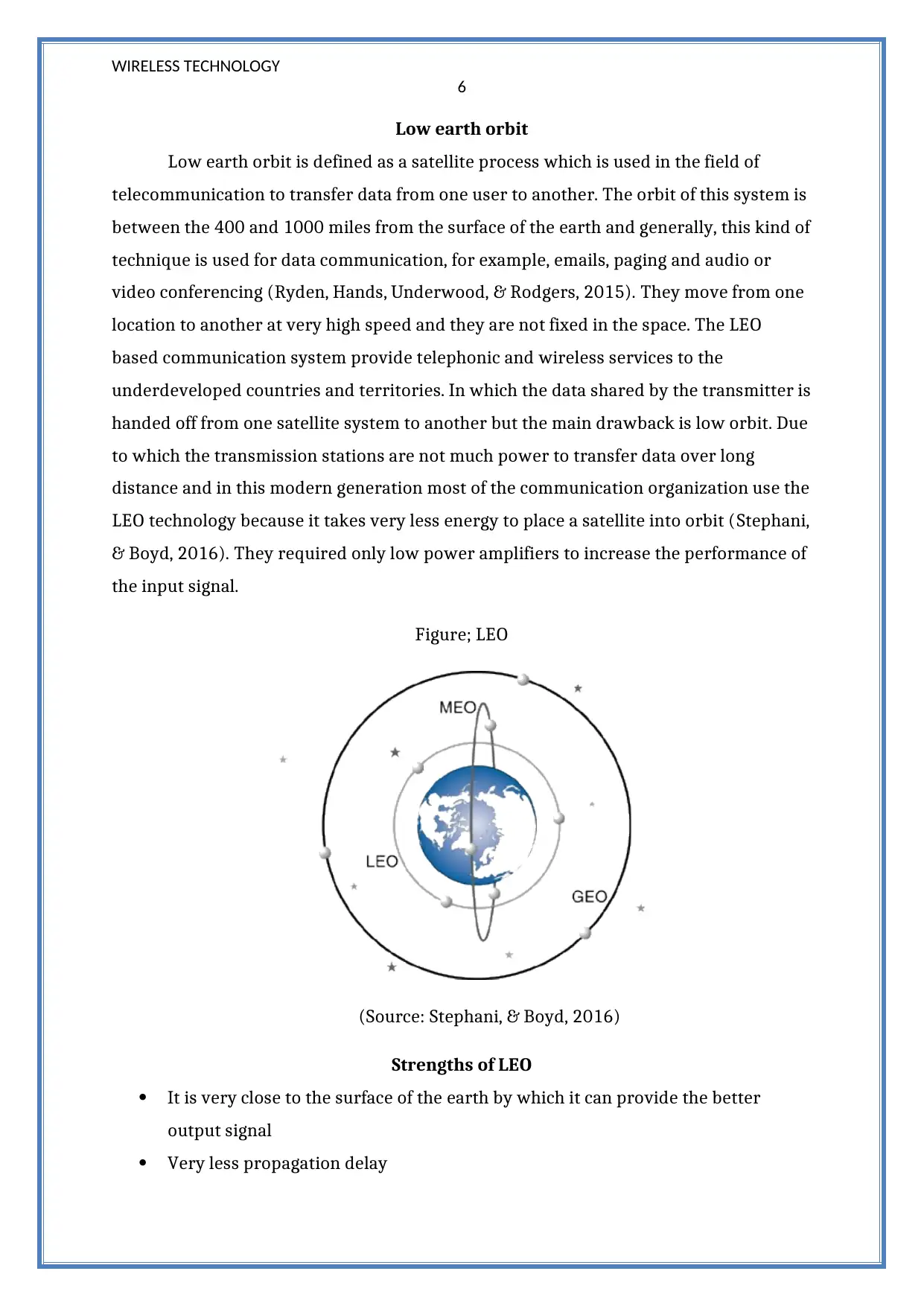
WIRELESS TECHNOLOGY
6
Low earth orbit
Low earth orbit is defined as a satellite process which is used in the field of
telecommunication to transfer data from one user to another. The orbit of this system is
between the 400 and 1000 miles from the surface of the earth and generally, this kind of
technique is used for data communication, for example, emails, paging and audio or
video conferencing (Ryden, Hands, Underwood, & Rodgers, 2015). They move from one
location to another at very high speed and they are not fixed in the space. The LEO
based communication system provide telephonic and wireless services to the
underdeveloped countries and territories. In which the data shared by the transmitter is
handed off from one satellite system to another but the main drawback is low orbit. Due
to which the transmission stations are not much power to transfer data over long
distance and in this modern generation most of the communication organization use the
LEO technology because it takes very less energy to place a satellite into orbit (Stephani,
& Boyd, 2016). They required only low power amplifiers to increase the performance of
the input signal.
Figure; LEO
(Source: Stephani, & Boyd, 2016)
Strengths of LEO
It is very close to the surface of the earth by which it can provide the better
output signal
Very less propagation delay
6
Low earth orbit
Low earth orbit is defined as a satellite process which is used in the field of
telecommunication to transfer data from one user to another. The orbit of this system is
between the 400 and 1000 miles from the surface of the earth and generally, this kind of
technique is used for data communication, for example, emails, paging and audio or
video conferencing (Ryden, Hands, Underwood, & Rodgers, 2015). They move from one
location to another at very high speed and they are not fixed in the space. The LEO
based communication system provide telephonic and wireless services to the
underdeveloped countries and territories. In which the data shared by the transmitter is
handed off from one satellite system to another but the main drawback is low orbit. Due
to which the transmission stations are not much power to transfer data over long
distance and in this modern generation most of the communication organization use the
LEO technology because it takes very less energy to place a satellite into orbit (Stephani,
& Boyd, 2016). They required only low power amplifiers to increase the performance of
the input signal.
Figure; LEO
(Source: Stephani, & Boyd, 2016)
Strengths of LEO
It is very close to the surface of the earth by which it can provide the better
output signal
Very less propagation delay
Paraphrase This Document
Need a fresh take? Get an instant paraphrase of this document with our AI Paraphraser
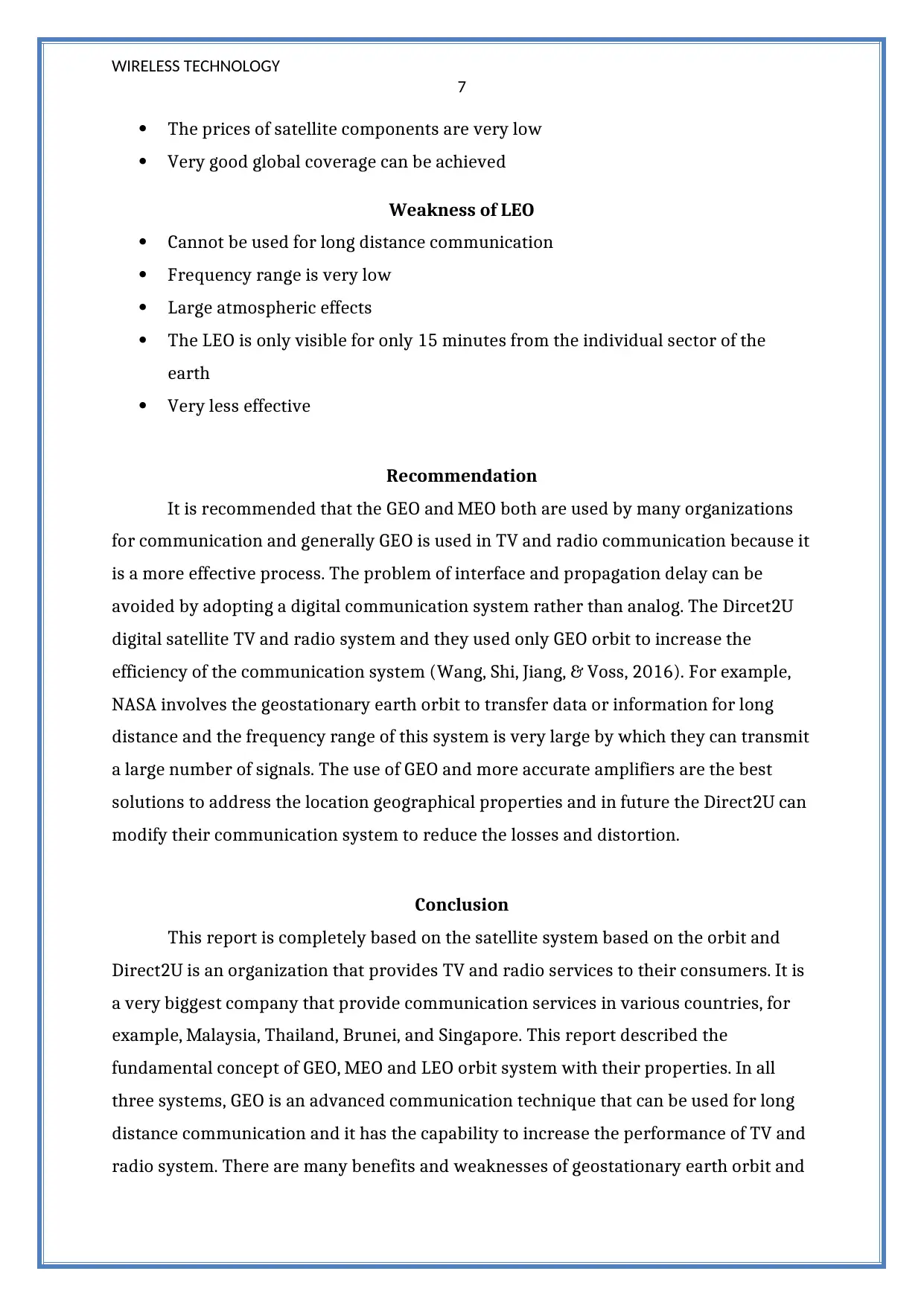
WIRELESS TECHNOLOGY
7
The prices of satellite components are very low
Very good global coverage can be achieved
Weakness of LEO
Cannot be used for long distance communication
Frequency range is very low
Large atmospheric effects
The LEO is only visible for only 15 minutes from the individual sector of the
earth
Very less effective
Recommendation
It is recommended that the GEO and MEO both are used by many organizations
for communication and generally GEO is used in TV and radio communication because it
is a more effective process. The problem of interface and propagation delay can be
avoided by adopting a digital communication system rather than analog. The Dircet2U
digital satellite TV and radio system and they used only GEO orbit to increase the
efficiency of the communication system (Wang, Shi, Jiang, & Voss, 2016). For example,
NASA involves the geostationary earth orbit to transfer data or information for long
distance and the frequency range of this system is very large by which they can transmit
a large number of signals. The use of GEO and more accurate amplifiers are the best
solutions to address the location geographical properties and in future the Direct2U can
modify their communication system to reduce the losses and distortion.
Conclusion
This report is completely based on the satellite system based on the orbit and
Direct2U is an organization that provides TV and radio services to their consumers. It is
a very biggest company that provide communication services in various countries, for
example, Malaysia, Thailand, Brunei, and Singapore. This report described the
fundamental concept of GEO, MEO and LEO orbit system with their properties. In all
three systems, GEO is an advanced communication technique that can be used for long
distance communication and it has the capability to increase the performance of TV and
radio system. There are many benefits and weaknesses of geostationary earth orbit and
7
The prices of satellite components are very low
Very good global coverage can be achieved
Weakness of LEO
Cannot be used for long distance communication
Frequency range is very low
Large atmospheric effects
The LEO is only visible for only 15 minutes from the individual sector of the
earth
Very less effective
Recommendation
It is recommended that the GEO and MEO both are used by many organizations
for communication and generally GEO is used in TV and radio communication because it
is a more effective process. The problem of interface and propagation delay can be
avoided by adopting a digital communication system rather than analog. The Dircet2U
digital satellite TV and radio system and they used only GEO orbit to increase the
efficiency of the communication system (Wang, Shi, Jiang, & Voss, 2016). For example,
NASA involves the geostationary earth orbit to transfer data or information for long
distance and the frequency range of this system is very large by which they can transmit
a large number of signals. The use of GEO and more accurate amplifiers are the best
solutions to address the location geographical properties and in future the Direct2U can
modify their communication system to reduce the losses and distortion.
Conclusion
This report is completely based on the satellite system based on the orbit and
Direct2U is an organization that provides TV and radio services to their consumers. It is
a very biggest company that provide communication services in various countries, for
example, Malaysia, Thailand, Brunei, and Singapore. This report described the
fundamental concept of GEO, MEO and LEO orbit system with their properties. In all
three systems, GEO is an advanced communication technique that can be used for long
distance communication and it has the capability to increase the performance of TV and
radio system. There are many benefits and weaknesses of geostationary earth orbit and
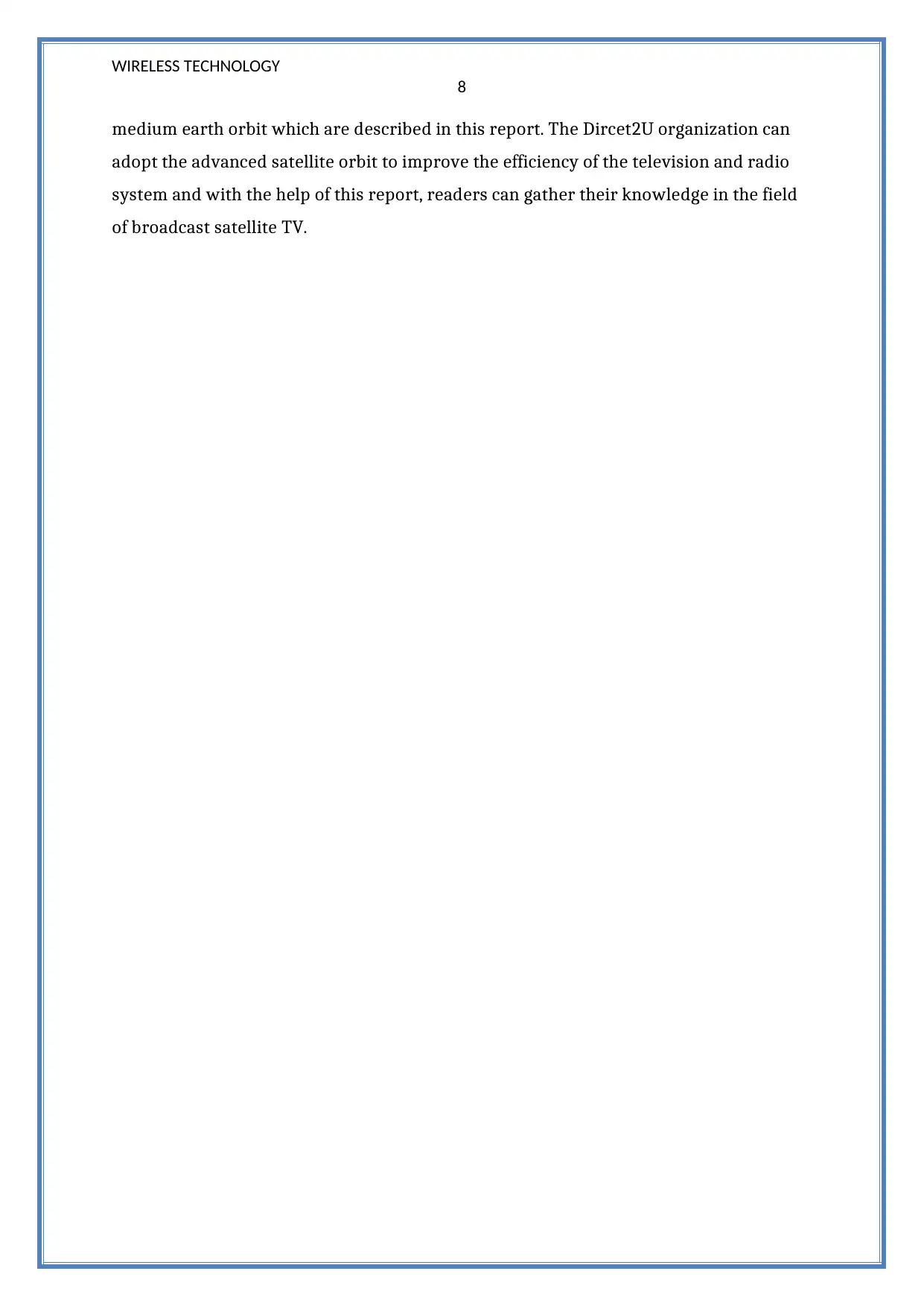
WIRELESS TECHNOLOGY
8
medium earth orbit which are described in this report. The Dircet2U organization can
adopt the advanced satellite orbit to improve the efficiency of the television and radio
system and with the help of this report, readers can gather their knowledge in the field
of broadcast satellite TV.
8
medium earth orbit which are described in this report. The Dircet2U organization can
adopt the advanced satellite orbit to improve the efficiency of the television and radio
system and with the help of this report, readers can gather their knowledge in the field
of broadcast satellite TV.
⊘ This is a preview!⊘
Do you want full access?
Subscribe today to unlock all pages.

Trusted by 1+ million students worldwide
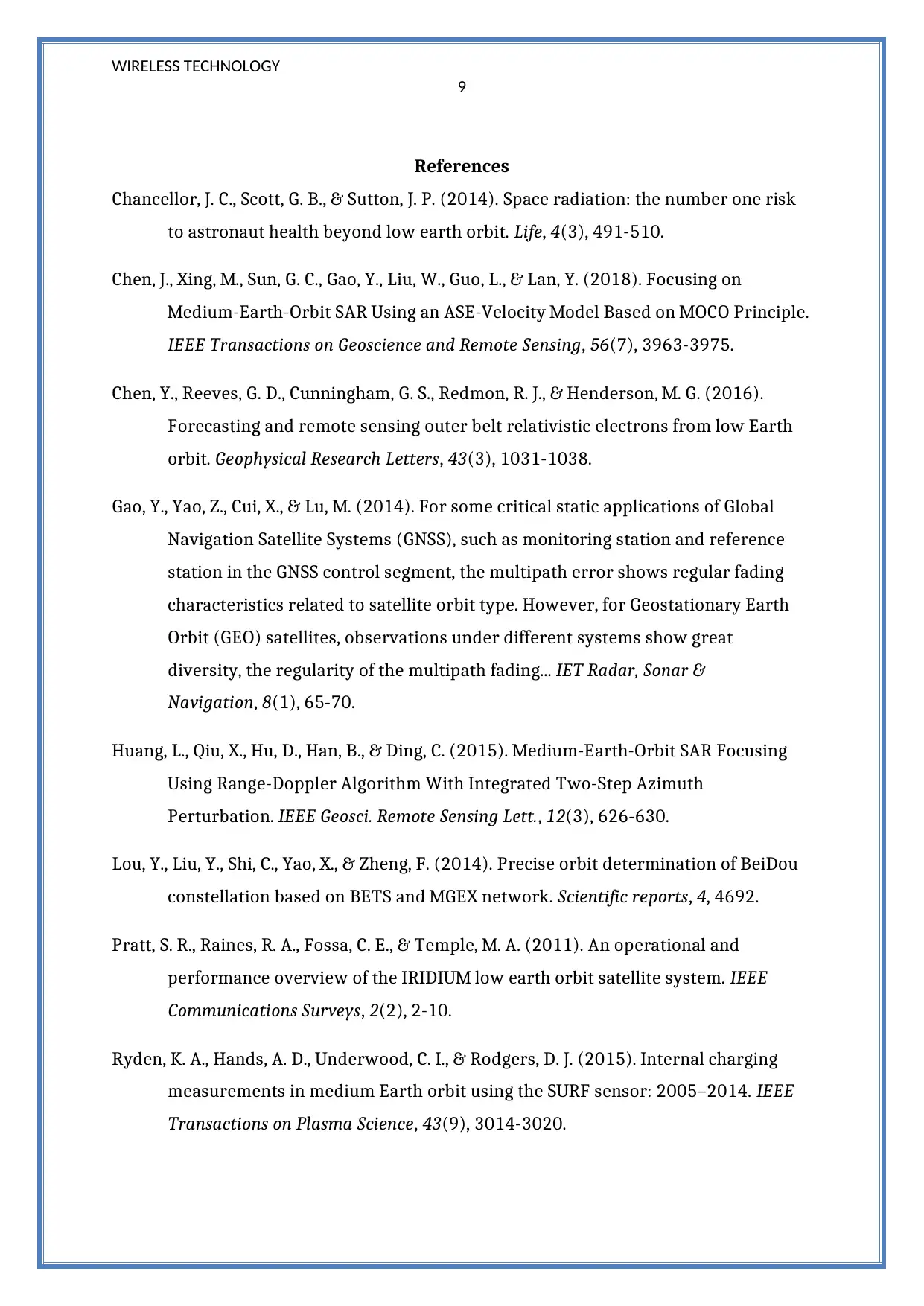
WIRELESS TECHNOLOGY
9
References
Chancellor, J. C., Scott, G. B., & Sutton, J. P. (2014). Space radiation: the number one risk
to astronaut health beyond low earth orbit. Life, 4(3), 491-510.
Chen, J., Xing, M., Sun, G. C., Gao, Y., Liu, W., Guo, L., & Lan, Y. (2018). Focusing on
Medium-Earth-Orbit SAR Using an ASE-Velocity Model Based on MOCO Principle.
IEEE Transactions on Geoscience and Remote Sensing, 56(7), 3963-3975.
Chen, Y., Reeves, G. D., Cunningham, G. S., Redmon, R. J., & Henderson, M. G. (2016).
Forecasting and remote sensing outer belt relativistic electrons from low Earth
orbit. Geophysical Research Letters, 43(3), 1031-1038.
Gao, Y., Yao, Z., Cui, X., & Lu, M. (2014). For some critical static applications of Global
Navigation Satellite Systems (GNSS), such as monitoring station and reference
station in the GNSS control segment, the multipath error shows regular fading
characteristics related to satellite orbit type. However, for Geostationary Earth
Orbit (GEO) satellites, observations under different systems show great
diversity, the regularity of the multipath fading... IET Radar, Sonar &
Navigation, 8(1), 65-70.
Huang, L., Qiu, X., Hu, D., Han, B., & Ding, C. (2015). Medium-Earth-Orbit SAR Focusing
Using Range-Doppler Algorithm With Integrated Two-Step Azimuth
Perturbation. IEEE Geosci. Remote Sensing Lett., 12(3), 626-630.
Lou, Y., Liu, Y., Shi, C., Yao, X., & Zheng, F. (2014). Precise orbit determination of BeiDou
constellation based on BETS and MGEX network. Scientific reports, 4, 4692.
Pratt, S. R., Raines, R. A., Fossa, C. E., & Temple, M. A. (2011). An operational and
performance overview of the IRIDIUM low earth orbit satellite system. IEEE
Communications Surveys, 2(2), 2-10.
Ryden, K. A., Hands, A. D., Underwood, C. I., & Rodgers, D. J. (2015). Internal charging
measurements in medium Earth orbit using the SURF sensor: 2005–2014. IEEE
Transactions on Plasma Science, 43(9), 3014-3020.
9
References
Chancellor, J. C., Scott, G. B., & Sutton, J. P. (2014). Space radiation: the number one risk
to astronaut health beyond low earth orbit. Life, 4(3), 491-510.
Chen, J., Xing, M., Sun, G. C., Gao, Y., Liu, W., Guo, L., & Lan, Y. (2018). Focusing on
Medium-Earth-Orbit SAR Using an ASE-Velocity Model Based on MOCO Principle.
IEEE Transactions on Geoscience and Remote Sensing, 56(7), 3963-3975.
Chen, Y., Reeves, G. D., Cunningham, G. S., Redmon, R. J., & Henderson, M. G. (2016).
Forecasting and remote sensing outer belt relativistic electrons from low Earth
orbit. Geophysical Research Letters, 43(3), 1031-1038.
Gao, Y., Yao, Z., Cui, X., & Lu, M. (2014). For some critical static applications of Global
Navigation Satellite Systems (GNSS), such as monitoring station and reference
station in the GNSS control segment, the multipath error shows regular fading
characteristics related to satellite orbit type. However, for Geostationary Earth
Orbit (GEO) satellites, observations under different systems show great
diversity, the regularity of the multipath fading... IET Radar, Sonar &
Navigation, 8(1), 65-70.
Huang, L., Qiu, X., Hu, D., Han, B., & Ding, C. (2015). Medium-Earth-Orbit SAR Focusing
Using Range-Doppler Algorithm With Integrated Two-Step Azimuth
Perturbation. IEEE Geosci. Remote Sensing Lett., 12(3), 626-630.
Lou, Y., Liu, Y., Shi, C., Yao, X., & Zheng, F. (2014). Precise orbit determination of BeiDou
constellation based on BETS and MGEX network. Scientific reports, 4, 4692.
Pratt, S. R., Raines, R. A., Fossa, C. E., & Temple, M. A. (2011). An operational and
performance overview of the IRIDIUM low earth orbit satellite system. IEEE
Communications Surveys, 2(2), 2-10.
Ryden, K. A., Hands, A. D., Underwood, C. I., & Rodgers, D. J. (2015). Internal charging
measurements in medium Earth orbit using the SURF sensor: 2005–2014. IEEE
Transactions on Plasma Science, 43(9), 3014-3020.
Paraphrase This Document
Need a fresh take? Get an instant paraphrase of this document with our AI Paraphraser
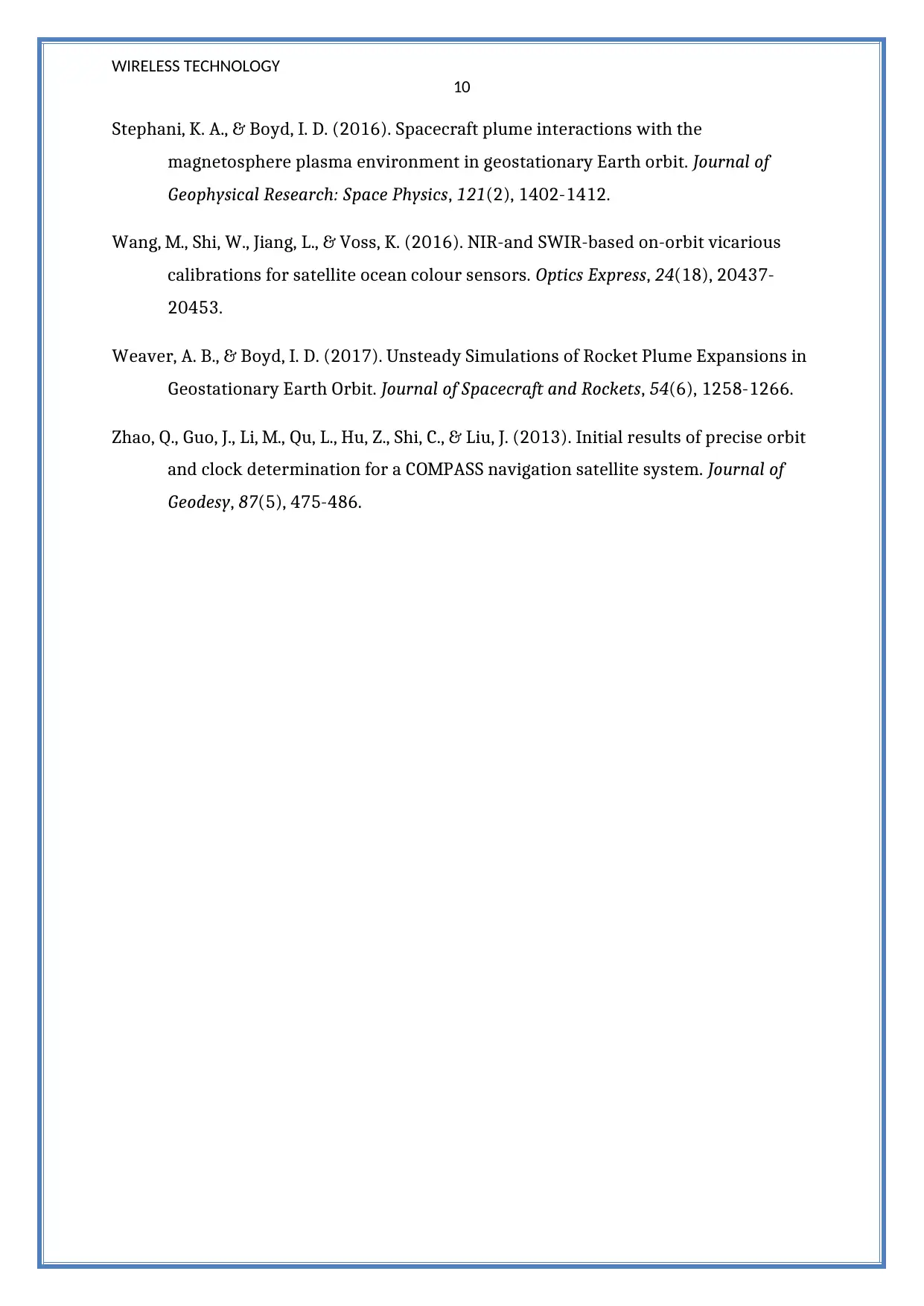
WIRELESS TECHNOLOGY
10
Stephani, K. A., & Boyd, I. D. (2016). Spacecraft plume interactions with the
magnetosphere plasma environment in geostationary Earth orbit. Journal of
Geophysical Research: Space Physics, 121(2), 1402-1412.
Wang, M., Shi, W., Jiang, L., & Voss, K. (2016). NIR-and SWIR-based on-orbit vicarious
calibrations for satellite ocean colour sensors. Optics Express, 24(18), 20437-
20453.
Weaver, A. B., & Boyd, I. D. (2017). Unsteady Simulations of Rocket Plume Expansions in
Geostationary Earth Orbit. Journal of Spacecraft and Rockets, 54(6), 1258-1266.
Zhao, Q., Guo, J., Li, M., Qu, L., Hu, Z., Shi, C., & Liu, J. (2013). Initial results of precise orbit
and clock determination for a COMPASS navigation satellite system. Journal of
Geodesy, 87(5), 475-486.
10
Stephani, K. A., & Boyd, I. D. (2016). Spacecraft plume interactions with the
magnetosphere plasma environment in geostationary Earth orbit. Journal of
Geophysical Research: Space Physics, 121(2), 1402-1412.
Wang, M., Shi, W., Jiang, L., & Voss, K. (2016). NIR-and SWIR-based on-orbit vicarious
calibrations for satellite ocean colour sensors. Optics Express, 24(18), 20437-
20453.
Weaver, A. B., & Boyd, I. D. (2017). Unsteady Simulations of Rocket Plume Expansions in
Geostationary Earth Orbit. Journal of Spacecraft and Rockets, 54(6), 1258-1266.
Zhao, Q., Guo, J., Li, M., Qu, L., Hu, Z., Shi, C., & Liu, J. (2013). Initial results of precise orbit
and clock determination for a COMPASS navigation satellite system. Journal of
Geodesy, 87(5), 475-486.
1 out of 11
Related Documents
Your All-in-One AI-Powered Toolkit for Academic Success.
+13062052269
info@desklib.com
Available 24*7 on WhatsApp / Email
![[object Object]](/_next/static/media/star-bottom.7253800d.svg)
Unlock your academic potential
Copyright © 2020–2025 A2Z Services. All Rights Reserved. Developed and managed by ZUCOL.





